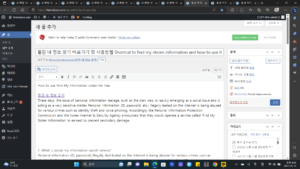These days, the issue of personal information leakage, such as the dark web, is rapidly emerging as a social issue and is acting as a very sensitive matter. Personal information (ID, password, etc.) illegally leaked on the Internet is being abused for various crimes such as identity theft and voice phishing. Accordingly, the Personal Information Protection Commission and the Korea Internet & Security Agency announced that they would operate a service called ‘Find My Stolen Information’ in earnest to prevent secondary damage.

1. What is stolen my information search service?
Personal information (ID, password) illegally distributed on the Internet is being abused for various crimes such as identity theft and voice phishing. . The stolen My Info service encrypts the account information (ID, password) entered by the user, performs only simple comparison, and does not store or store plain text data.
2. What is the Dark Web?
The dark web is a web that can only be accessed through a special browser, and is often used for black markets due to its anonymity and impossibility of tracking. On the dark web, which is well known for the nth room incident, personal information, forgery, drugs, hacking information, and sexual exploitation are circulated, becoming a social problem.
Enactment of the Nth Room Prevention Act
Attention is focused on the so-called ‘nth room prevention law’ to eradicate digital sex crimes. In particular, the Telegram nth room incident served as a decisive opportunity for the National Assembly to pass legislation to strengthen punishment for digital sex crimes and prevent recurrence.
alltop4.tistory.com
3. How to use Find My Information Stolen
Site Access: After 10:00 am on November 16th, you can access the ‘Find My Stolen Information Service’ (kidc.eprivacy.go.kr) service.
User authentication: Agree to the terms and conditions, email authentication, and even secondary authentication through ReCAPTCHA.
Leakage Inquiry: You can enter up to 5 account information (ID, password) to check leakage.
Outcome Information: Appropriate follow-up measures should be taken depending on whether or not there was a spill.
4. If there is a history of personal information leakage
If there is a history of leakage, you can immediately change your password to prevent secondary leakage damages such as ‘identity theft, fraudulent transaction, voice phishing, etc.’
In particular, it is recommended to change to a secure password by referring to the ‘Password selection and usage guide’ posted in the notice.
If you suspect identity theft or if it is difficult to withdraw from membership because you do not know your ID and password, please use the ‘e-Privacy Clean Service’ operated by the Personal Information Protection Committee.
Since the above service provides an agency service for handling membership withdrawal, users are requested to safely manage their personal information by withdrawing membership from websites that have not been used or accessed for a long time.
5. Rules of life to follow and abide by personal information that is inadvertently stolen
Do not share my account information with others
Set up ‘2-Step Verification’ when logging in to social media, cloud, etc.
Unsubscribe and delete unused apps
Do not click and delete suspicious links (URLs) from unknown sources
Initialization (formatting) settings for used devices such as smartphones and PCs
Do not expose the faces or location information of people around you during live broadcasting
Check for personal information when uploading posts, comments, photos, or videos
Beware of leakage of personal information through courier invoices, credit card receipts, etc.
Be suspicious of part-time jobs or events that require excessive personal information
Using QR check-in, personal safety number, and safety call when visiting multi-use facilities